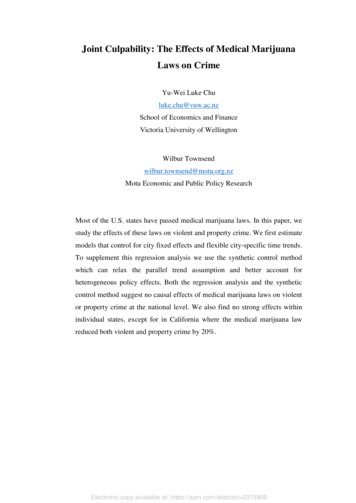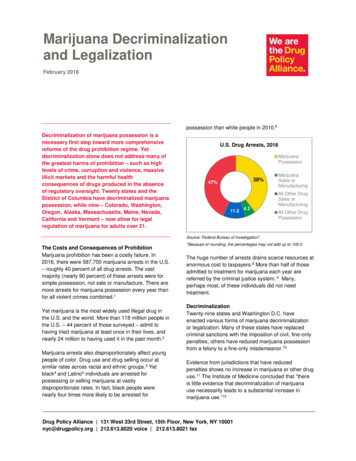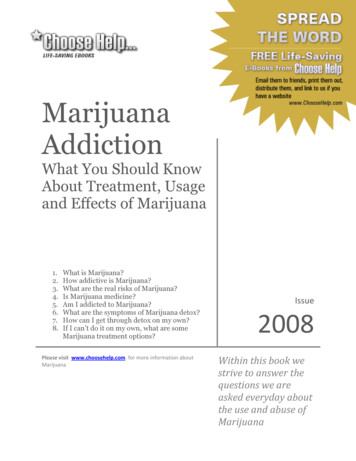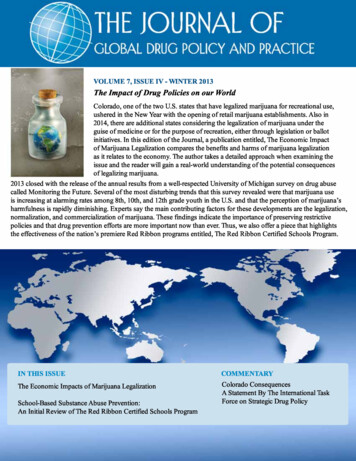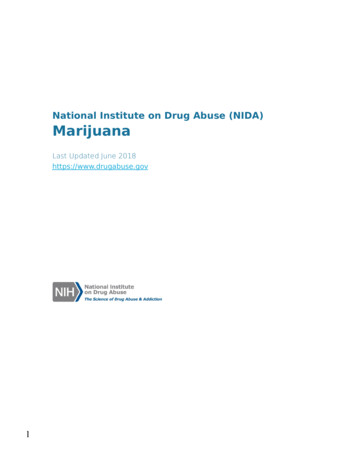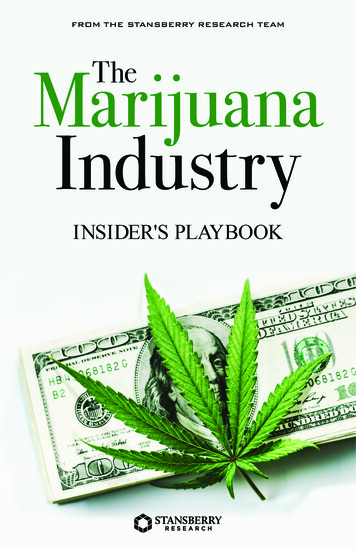
Transcription
The Marijuana Industry Insider’s PlaybookCopyright 2018 by Stansberry Research. All Rights Reserved.All rights reserved. No part of this book may be reproduced in any form or by any electronic or mechanicalmeans including information storage and retrieval systems, without permission in writing from the author.The only exception is by a reviewer, who may quote short excerpts in a review.Designed by Lauren ThorsenContent edited by Fawn GwynallenCover and Section page illustration credit: iStock/YaryginStansberry ResearchVisit our website at www.StansberryResearch.comPrinted in the United States of AmericaFirst Printing: March 2018Stansberry ResearchISBN- 978-0-9978333-5-5
About Stansberry ResearchFounded in 1999 and based out of Baltimore, Maryland, StansberryResearch is the largest independent source of financial insight inthe world. It delivers unbiased investment advice to self-directedinvestors seeking an edge in a wide variety of sectors and marketconditions.Stansberry Research has nearly two dozen analysts and researchers– including former hedge-fund managers and buy-side financialexperts. They produce a steady stream of timely research on valueinvesting, income generation, resources, biotech, financials, shortselling, macroeconomic analysis, options trading, and more.The company’s unrelenting and uncompromised insight has made itone of the most respected and sought-after research organizations inthe financial sector. It has nearly 200 employees operating in severaloffices in the U.S. plus one in Asia, and it serves 350,000 customersin more than 120 countries.
Table of ContentsForeword: This Controversial Market Is Set to BoomBy Nick GiambrunoiNorth America’s Fastest Growth SectorBy Michael Ford1PART IConversations With the ExpertsWhat Is This Marijuana Trend?A Viable Supplement for Living a Healthy LifeWill Kleidon19Pioneering the Cannabis Business in America TodayMichael Lang33The Future of Legal MarijuanaMatt McCall47The No. 1 Factor for Success in the Cannabis IndustryDoug Esposito63This Man Set the Foundation for the Cannabis EconomyAaron Salz81Canada’s Most Connected Venture CapitalistMatt Shalhoub89The CEO of the World’s Largest Legal Cannabis CompanyBruce Linton97
The Hidden Value in Legal MarijuanaTodd Harrison105PART IIMaking a Fortune in Legal MarijuanaHow the Millionaires Did It and How You Can, TooMarijuana Millionaires: How Regular Investors Are Cashingin on the Next Big Boom125The Potential Winners of the Global Marijuana Boom141Get Your Degree in Smart Trading Basics: Three Waysto Manage Risk157Putting It All Together167
Foreword– Foreword –This Controversial MarketIs Set to BoomBy Nick Giambruno, Senior Editor, Casey ResearchThe U.S. is about to experience one of its biggest social andeconomic changes in generations.And the story of Desert Hot Springs, California is the key tounderstanding it all Like many U.S. cities, Desert Hot Springs had chronic financialproblems. The city filed for Chapter 9 municipal bankruptcy in 2001.Then it nearly went bankrupt again in 2014, when it declared a fiscalemergency.At this point, the city’s people were desperate to solve their intractablefinancial troubles. So they opened their minds to a new idea.They voted to become the first place in California to allow indoorcannabis cultivation on an industrial scale. A full 70% of votes werein favor.The city would, of course, tax these operations.Local politicians had nixed the idea before. But the risk of twobankruptcies in 15 years changed their minds. Necessity has a way ofdoing that.As we begin 2018, this once-dying city of 29,000 people – the forgottenneighbor of storied Palm Springs – is experiencing a renaissance.i
The Marijuana Industry Insider’s PlaybookSince the vote, it has issued permits to more than 30 growers formore than 3 million square feet of cannabis cultivation.Hundreds of new jobs have been created. Previously vacantindustrial real estate is buzzing with activity.The local government now has a 15 million budget to pay itsemployees and run the city. Yet it’s expected to take in 50 million incannabis taxes alone.Desert Hot Springs has gone from a dying pit stop with big moneytroubles to a booming city with more cash than it knows what to do with.This is why widespread cannabis legalization is bothinevitable and imminent: money.Many places in the U.S. have similar stories.Just look at Colorado. In 2017, the state’s marijuana industrygenerated 1.3 billion in sales and 200 million in tax revenue. Adecade ago, Colorado received zero dollars in marijuana taxes.The industry also created 18,000 new full-time jobs. And that’s justone state.According to Bloomberg, the state of Washington will generate 155million in cannabis-related taxes in 2018. After four years, thatnumber is expected to exceed 1 billion.In California – which started selling recreational cannabis legally onJanuary 1, 2018 – cannabis taxes are projected to bring in at least 1.4billion each year and create more than 100,000 new jobs by 2020.In many of the states that have or will legalize cannabis, the taxrevenue will exceed that of alcohol and tobacco. That’s not somethinga cash-strapped state can turn its back on.All that money will quickly become a permanent part of many statebudgets. This will encourage other states to follow suit.It’s important to clarify something here ii
ForewordThe U.S. has a population of 320 million. Yet it has more people inprison than China, which has a population of 1.4 billion.The U.S. also has a higher percentage of its population in prisonthan North Korea, Cuba, Iran, Syria, or any of the other countries itroutinely demonizes.The war on (some) drugs – and cannabis Prohibition in particular –is the biggest reason why the U.S. is still No. 1 at something: lockingpeople up.This pointless war has killed an untold number of people. It’s putmillions of nonviolent offenders behind bars. It’s even ravaged entirecountries, like Mexico and Colombia.I’m not celebrating a new way for state and municipal governmentsto steal money from people voluntarily exchanging goods andservices. I think taxation is morally indistinguishable from theft.But taxing cannabis – rather than prohibiting it outright – meansmore personal freedom and less government coercion. It’s a big stepin the right direction.Leaders around the world are rethinking marijuana Prohibition.Many longtime “drug warriors” are even changing their tune.Prohibition is an unsustainable distortion in the cannabis market – adistortion that you can take advantage of to make massive profits.Widespread Legalization Is ImminentAccording to a Gallup poll, 64% of Americans say cannabis should betotally legal. That’s the highest level of support since polling on thisissue started 48 years ago.In 2018, opposition to legalization has dropped to an all-time low ofjust 34%.Meanwhile, support has more than doubled since 2000. And as youcan see in the following chart, it’s continuing to grow iii
The Marijuana Industry Insider’s PlaybookAMERICANS' SUPPORT FOR LEGALIZEDMARIJUANA CONTINUES TO RISE70%60%50%40%30%20%10%0%Percentage of Americans for legalization80%1970 1975 1980 1985 1990 1995 2000 2005 2010 2015www.stansberryresearch.comSource: Gallup, Casey ResearchAs of early January 2018, 29 states (plus Washington, D.C.) haveapproved legalized medical marijuana. And eight states (plus D.C.)have approved recreational use.It’s only a matter of time before other states do the same, especiallythose with budget problems. And eventually, the U.S. federalgovernment will as well.The economic benefits of legalization are simply too good to pass up.It’s absurd, but the U.S. federal government still classifies marijuanaas a Schedule I drug. In other words, the feds put marijuana inthe same category as heroin and LSD – and they consider it moredangerous than cocaine or meth.But this ridiculous policy probably won’t last much longer.Of course, you might be worried that the Trump administration willshut down the legal cannabis industry – along with your chance toprofit from it.And there’s good reason to be cautious. After all, Trump’s attorneygeneral did call marijuana “slightly less awful” than heroin.iv
ForewordComments like this have stopped many people from investing inmarijuana. But consider the bigger political picture.First, the industry is too big to shut down. There’s simply toomuch money and too many jobs at stake. The backlash would beoverwhelming.For example, now that recreational pot is legal in California, the U.S.legal marijuana market is expected to grow from 6.5 billion to 50billion by 2026. That would make it the same size as the Americancraft beer and chocolate markets combined.Second, states’ rights matter to Trump voters. Cracking downon the industry would alienate the people who put him in office.The new jobs and desperately needed tax revenue will make itpolitically impossible to roll back legalization.Attacking the U.S. marijuana industry would cost Trump a lot morethan it’s politically worth. It wouldn’t make any sense to do it.The Birth of a 150 Billion IndustryThe United Nations estimates the global cannabis market to be wortharound 150 billion annually. That’s very conservative.For perspective, about 33 billion worth of coffee is producedannually. So the marijuana market is almost five times bigger thanthe coffee market.It’s also bigger than the iron, copper, aluminum, silver, corn, andwheat markets. You can see how these commodity markets stack upin the chart on the following page v
The Marijuana Industry Insider’s PlaybookMARIJUANA DWARFS OTHERMAJOR COMMODITY MARKETS 175 125 100 75 50 25Annual production value (in billions) ornMarijuanGold 0Source: Statista, The World Gold Council, The Silver Institute, The United Nations, Casey Researchwww.stansberryresearch.comUntil now, almost all of this money has been underground. But that’sabout to change.The end of marijuana Prohibition means we can finally profit offmarijuana without risking jail time.Widespread marijuana legalization is inevitable. It’s happening. Andit’s unleashing a 150 billion market that was once underground.Those profits are up for grabs.In the coming months, many investors will make life-changingfortunes as the marijuana market steps into the light.For now, though, marijuana is still illegal in most places.Up until recently, that made it virtually impossible for regularinvestors to cash in on the lucrative marijuana trade.Prohibition has funneled billions of dollars in profits to drug lords,corrupt government officials, and thugs.vi
ForewordThose days are numbered The end of marijuana Prohibition in the U.S. became inevitablethe moment California voters decided to legalize recreational use.Reversing this trend now would be more difficult than pushing a20,000-pound boulder back up a mountain with your bare hands.I’ve never seen an opportunity with as much profit potential as legalmarijuana has right now Investing in the nascent cannabis industry right now is likeinvesting in the beer industry at the tail end of Prohibition:Fortunes are going to be made. And you can be a part of that.In this book, Michael Ford and the Stansberry Research team explorethe cannabis industry – including why it’s here to stay, what you canexpect from this “new” commodity, and exactly how you can safelyprofit.The experts indicate this is no speculative bubble. Cannabis is in theearly innings of a major, long-term boom. Investors who get in on theground floor could make an absolute killing in the U.S. “green rush.”Regards,Nick GiambrunoJanuary 3, 2018vii
Introduction– Introduction –North America’s FastestGrowth SectorBy Michael FordIstill remember when the first marijuana dispensary opened nearmy house in Denver, Colorado.Seemingly overnight, Santa Fe Avenue transformed from usedcar lots into a row of vibrant buildings, all advertising: “MedicalMarijuana.” Billboards proudly shouted advertisements for highefficiency grow lights and hydroponic grow kits.2012 was an exciting year in Colorado. What we didn’t realize atthe time is that we were about to lead the country in a widespreadrevolution that would change the way much of the country viewed aonce taboo and misunderstood product.Hi, I’m Michael Ford.I come from a family of entrepreneurs. My father co-founded amultibillion-dollar business when I was a child, developing an entireindustry in the days before the Internet. Growing up in that kind ofenvironment – and now as a writer for Stansberry Research, one ofthe premier investment advisory publishers in the financial industry– business has always fascinated me.And it’s that mentality that drew me to explore the legal marijuanaindustry.1
The Marijuana Industry Insider’s PlaybookYou see, love it or hate it. support the legalization anddecriminalization of marijuana or not. the cannabis trend sweepingthe globe these days isn’t about hipster millennials throwing cautionto the winds and taking over the world.This is a legitimate, profitable business with incredible potential forboth entrepreneurs and investors. as well as the countries they livein.The legal marijuana market is one of the few opportunities in ageneration where you can get in early on the next household-nameindustry.This is like the invention of the computer. the birth of the Internet.and even the resurgence of the alcohol industry after Prohibition.Business Insider reports that in 2016, legal marijuana sales in NorthAmerica totaled just 6.7 billion, while the illicit market brought inmore than 46 billion.In other words, more than 85% of marijuana consumershaven’t moved over to the “legal” market yet.And there’s still time to invest ahead of this massive consumer shift.ArcView Market Research estimates that the legal cannabis businessis on track to reach 24.5 billion in sales by 2021 – a 265% increasefrom early 2018 levels.It also estimates that by 2025, the legal market alone will surpass 50 billion – a 650% increase in less than a decade.To put that in perspective.Chicken and eggs are a 40 billion market.Wine is a 38 billion market.Dairy is a 35 billion market.2
Introduction 50 40 20Billions 30 10CannabisChicken & eggsWinewww.stansberryresearch.comDairy 0Source: ArcView Market ResearchWe’re talking about a brand-new market that will soon outsellpoultry, wine, and milk. And we’re talking about a rare situationwhere regulations prohibiting marijuana sales are evaporating fasterthan merchants can open up shop.Today, no single company has more than 1% of the market.In other words, the big money is still up for grabs.There are millions, if not billions, of dollars to be made from thelegalization of marijuana in the United States alone.That may explain why, in 2017, the top companies in this spacesaw their share prices soar by nearly 300%. Some individual namesclimbed 1,000% or more.3
The Marijuana Industry Insider’s PlaybookBut you haven’t missed out.This isn’t a fad or a quick bubble. Despite opposition from the highestlevels of government, industry insiders say the legal marijuanaindustry is here to stay.Speculating on marijuana stocks isn’t right for everyone. And we donot actively recommend any of the companies analyzed in this book.But if you decide this industry is right for you, it could be incrediblylucrative for disciplined investors.Take Terra Tech, for example. It has interests in 12 subsidiariesin the marijuana industry, including businesses focused on growoperation technology and cannabis-permitting technology.I mention it because one of the company’s subsidiaries, Blum – acannabis dispensary in Oakland, California – may be the mostprofitable single store location in the world by revenue.The dispensary churns out an astounding 7,000 per square foot.That’s 25% more income per square foot than the average Apple Store.4
IntroductionTo put that in perspective, the Apple Store makes more money on asquare-foot basis than any other publicly traded company in the world.Terra Tech is not a company I’d tell you to run out and buy today.The Blum dispensary represents just a small part of Terra’s portfolio.But the revenue this single marijuana dispensary generates speaksvolumes about how much stands to be made in the coming years asthe industry matures.Our job is not to guide your moral compass. It’s to help yougrow your wealth. Legal marijuana is one of the most dynamicand controversial markets in America. Many companies in thisburgeoning industry have the potential to generate thousands ofpercent returns for early investors. But the sector is also rife withrisk, misinformation, and hype.In this book, we’ll detail where you can find legitimate opportunities,what significant challenges still confront the industry, and whichcritical pitfalls to avoid.So What Is the ‘Legal Marijuana Industry’?Each year, consumers around the globe spend an estimated 150billion- 200 billion on their marijuana habit. Until recently, most ofthese sales took place on the “black market” because marijuana wasillegal in nearly every country. But this hugely profitable industry isfinally stepping into the light.In 2000, marijuana was illegal in nearly every jurisdiction on the planet.In 2018, 29 countries allow some form of marijuana consumption.A legalization movement is sweeping the globe, setting the stage for amassive new industry.The movement started when countries like Portugal beganexperimenting with decriminalization of marijuana possession.5
The Marijuana Industry Insider’s Playbook(Drugs were still illegal, but the sentence for possession was reducedto a small fine instead of jail time and a criminal record.)After decriminalizing drugs in 2001, overall drug use in Portugalsteadily declined. The prison population shrank. Drug-relatedoffenders accounted for just 21% of inmates in 2012 compared with44% in 1999. And Portuguese drug-related deaths fell to the secondlowest in the European Union.Other countries like Canada began legalizing marijuana for medicinaluse back in 2001. These early advocates paved the way for a globalmovement.Even Germany – which has some of the strictest narcotics laws inEurope – legalized medicinal marijuana in 2017. This move fromEurope’s largest economy shows that no country is immune from thetrend toward marijuana legalization.Many expect Italy will follow in Germany’s footsteps, which couldspark a chain reaction throughout Europe.Legalization is spreading across South America and the Asia-Pacific,too. Uruguay became the first country to fully legalize marijuana(medicinal and recreational) in 2013. Brazil decriminalizedmarijuana in 2006, followed by Mexico in 2009. Australia legalizedmedicinal marijuana in 2016. New Zealand will hold a nationalreferendum on full marijuana legalization by 2020.In the U.S., Colorado and Washington became the first states to legalizerecreational marijuana in 2012. By early 2018, more than half of U.S.states allowed medicinal or recreational marijuana consumption.Despite the groundswell of support among individual U.S. states,marijuana remains illegal on the federal level. This means thatfederal agents can arrest users and producers of marijuana, evenif they’re operating legally under their state laws. All indicationssuggest this will soon change.Gallup polling data shows the majority of Americans supportmarijuana legalization. This is a relatively recent phenomenon. In6
Introduction1996, only 25% of Americans favored legalization. That numbersoared to 64% in 2017.In other words, support for marijuana legalization isn’t just growing.its growth is accelerating.Despite the shift in global attitudes toward legalizing marijuana,skeptics abound.The naysayers compare today’s enthusiasm in the marijuana industrywith the cryptocurrency mania. But unlike cryptocurrencies, marijuanaisn’t based on a speculative rise in some intangible asset. The companiesin this space don’t need to build demand from scratch. The multibilliondollar global marijuana industry already exists – it’s just moving fromthe underground “black” market into a legal “white” market.We haven’t seen such a massive industry emerge from the blackmarket since the end of alcohol Prohibition in the 1930s. Theindisputable failures of alcohol Prohibition show why marijuanalegalization is all but unavoidable.Alcohol Prohibition: A Failed IdeaIn 1920, the U.S. government passed the 18th Amendment,which outlawed the production and sale of alcohol. Proponents ofProhibition argued that making alcohol illegal would. Solve social problems Reduce crime rates Decrease the prison population Lower taxes by reducing the need for police and prison systemsJust 13 years later, the outcome was clear: Alcohol Prohibitionwas one of the biggest national policy disasters in Americanhistory. The government admitted defeat and ended Prohibition in1933.7
The Marijuana Industry Insider’s PlaybookOn paper, Prohibition sounded like a good idea. But in practice, thepolicy created more problems than it solved.You see, governments cannot eliminate demand. Making highdemanded products illegal doesn’t make them disappear. It onlycreates a lucrative opportunity for criminals to supply the market.In the 1920s, alcohol was America’s fifth-largest industry. Peopleweren’t going to suddenly stop drinking. So all Prohibition didwas effectively hand this massive economic profit center overto criminals, fueling the rise of organized crime in the country.Businessmen in suits and ties were replaced with gangsters like AlCapone and Machine Gun Kelly.The emergence of large-scale criminal enterprise sparked a 78% risein America’s homicide rate during Prohibition. More crime meantmore arrests. The federal prison population more than quadrupled.By 1930, half of the new prisoners each year were charged withviolating Prohibition laws.Well-financed criminal organizations overwhelmed local policeforces. Entire new federal agencies were created to deal with thesurge in criminal activity. And since bootleggers and gangsters don’tpay taxes, the government missed out on valuable tax revenues thatwould have otherwise come from the legal liquor industry.So much for solving social problems, reducing crime rates,decreasing the prison population, and lowering taxes.Instead of improving the health of alcohol consumers, Prohibitioncreated new threats to health and safety. Criminal organizationsdon’t abide by the same rigorous health and safety regulations aslegal businesses. So liquor poisoning deaths soared four-fold duringthe first few years of Prohibition – from 1,064 per year in 1920 to4,154 per year in 1925.History is clear: Alcohol Prohibition actually boosted crime, explodedthe prison population, and made alcohol more dangerous. Plus, itdiverted economic profits and tax revenues into the hands of violentcriminal organizations.8
IntroductionAmerican satirist H.L. Mencken best described the failure of alcoholProhibition in 1925 (only five years into the program).Prohibition has not only failed in its promises, but actuallycreated additional serious and disturbing social problemsthroughout society. There is not less drunkenness in theRepublic, but more. There is not less crime, but more. Thecost of government is not smaller, but vastly greater.Despite this real-world case study in the failures of alcoholProhibition, the U.S. and most other countries pursued the sameflawed policy with marijuana in the 20th century.Marijuana Prohibition:Repeating the Mistakes of HistoryJust four years after the end of alcohol Prohibition, the U.S.government came down with a severe case of amnesia.In 1937, Congress passed the “Marihuana Tax Act of 1937.” (That’s nota typo. The arcane “marihuana” spelling started getting phased out ofpopular use in the 1960s, replaced by the modern “marijuana.”)This act effectively outlawed the drug. It was repealed in 1969. Butmarijuana became illegal again by 1970 when Congress passed theControlled Substances Act of 1970 as part of President Richard Nixon’sbroader “War on Drugs.” That act labeled marijuana as a Schedule Idrug. the most dangerous classification, with “no medical value.”Like alcohol Prohibition in the 1920s, making marijuana illegal createda new class of criminals. After remaining stable for decades leading upto the early 1970s, the U.S. prison population has surged more than400% since the War on Drugs began. This massively outpaced thegeneral population growth of about 50% during the same period.As of 2014, the United States housed the largest prison population onthe planet – ranking five to 10 times higher than other democracies9
The Marijuana Industry Insider’s Playbookaround the world. We can point directly to marijuana Prohibition asa leading cause. Each year, police arrest more people for marijuanapossession than for all violent crimes combined.This crackdown on marijuana costs taxpayers up to 20 billion eachyear, according to one Harvard economist. Unfortunately, we havenothing to show for this massive allocation of resources.With decades of data under our belts, studies show that nocorrelation exists between drug arrests and drug use. In otherwords, putting people in jail for consuming marijuana doesnothing to slow the rate of consumption.Marijuana consumption has soared in the last nearly five decades.A 2017 Gallup poll shows that 45% of Americans report having triedmarijuana in their lives. That number was only 12% in 1973.Even if you disagree with marijuana legalization, it’s clear thatthe drug does not belong in the Schedule I category. Unlike otherSchedule I drugs, like heroin and LSD, it’s practically impossible tooverdose on marijuana. even according to those in charge at theU.S. Drug Enforcement Administration (DEA).In a 1998 court case, a DEA judge argued that marijuana shouldbe removed from the Schedule I classification. The reason? Youwould need to consume the equivalent amount of THC containedin approximately 20,000 to 40,000 joints (marijuana cigarettes) tooverdose. In the words of Judge Francis Young.A smoker would theoretically have to consume nearly 1,500pounds of marijuana within about 15 minutes to induce alethal response.Despite humans consuming the drug for millennia, we have yetto record a single death from marijuana overdose. Yet somehow,marijuana is legally classified as more dangerous than Schedule IIdrugs like cocaine and methamphetamine.There’s only one group who benefits from making marijuana illegal:Criminals. Just like with alcohol Prohibition, illegal marijuana10
Introductionfunnels massive sums of money into the world’s most violentcriminal organizations. I’m talking about Mexican drug cartels who,until recently, supplied the majority of marijuana to U.S. consumers.All efforts to combat Mexican drug cartels with force have failed.Beginning in 2006, Mexico’s then-president Felipe Calderón mobilizedthe country’s military to rein in the cartels. But this only amplifiedthe violence. Since then, Mexico’s drug war has produced more than200,000 casualties. Plus, an estimated 30,000 missing persons.If you legalize marijuana, you destroy the cartels and thecrime that comes with them.The Benefits of Legalizing MarijuanaThe paradox of Prohibition is rooted in basic economics.The more drug dealers you take off the streets, the more supplycomes off the market. This sends prices up, creating a greaterincentive for other criminals to come in and fill the vacuum in supply.Like the mythical Greek water serpent Hydra, each head you removein the illegal drug trade only produces two more in its place.The proven way to eradicate criminal organizations is to attack theirprofit centers. We’ve seen early signs of this in the U.S., as a flood ofnew supply has hit the market from state-legalized producers.From 2008 to 2015, legal U.S. growers took away half of theMexican market share and pushed prices down. A December 2014NPR interview with a Mexican marijuana grower highlighted howAmerican decriminalization efforts could put him out of business.Two or three years ago, a kilogram of marijuana was worth 60 to 90. But now, they’re paying us 30 to 40 a kilo. It’sa big difference. If the U.S. continues to legalize pot, they’llrun us into the ground.11
The Marijuana Industry Insider’s PlaybookNot only will legalization take money away from criminals,but it will also generate economic growth and billions intax revenues. Studies show that U.S. legalized marijuana couldgenerate up to 132 billion in tax revenues and create more than amillion jobs by 2025.You can’t find a safer play than betting on politicians exploiting newsources of tax revenue. The promise of billions in marijuana taxes allbut ensures the industry eventually goes legal around the globe.Even many Republican lawmakers have reversed their stance againstlegalization. The clearest example of this came on the heels of anannouncement made by U.S. Attorney General Jeff Sessions.On January 4, 2018, Sessions rescinded an Obama-era JusticeDepartment guideline known as the Cole Memo. This memo seta precedent of noninterference from the federal level into statesponsored marijuana legalization, despite marijuana’s illegal statusunder U.S. federal law.In other words, the Cole Memo protected marijuana producers whooperated within the legal constructs of their home states. Removingthese protections sparked a backlash from voters and politicalleaders across both sides of the aisle. Fifty-four members of Congresssigned a letter asking Sessions to respect the will of voters and backoff his anti-marijuana efforts.One Republican congressman from Colorado – Mike Coffman– publicly questioned whether Sessions understood the U.S.Constitution. Less than 10 years earlier, Coffman staunchly opposedmarijuana legalization. He changed his position and became an ardentsupporter of legalization after Colorado legalized marijuana in 201
MARIJUANA DWARFS OTHER MAJOR COMMODITY MARKETS Gold ana n on Wheat Copper minum Zinc ee l er Annual production value (in billions) 100 50 175 150 75 25 125 0 Until now, almost all of this money has been underground. But that’s about to change. The end of marijuana Prohibition mean
